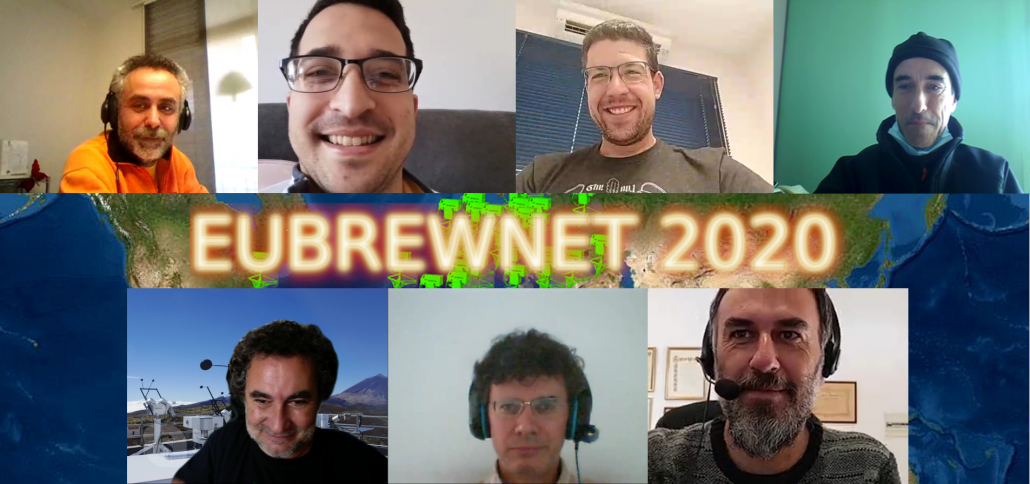Foreword
Dear EuBrewNet contributor – in our second newsletter we tell you how your data is being used by more and more researchers and how it is becoming more visible through cooperation with NDACC and WOUDC. Along with other technical updates, including the new version 2 algorithm, EuBrewNet also now offers more data products and file formats for data exchange with other networks.
EuBrewNet observations linked in the WOUDC
EuBrewNet total ozone observations are now accessible from WOUDC. Users can search EuBrewNet from the Data Search / Download page, and download resulting data directly from EuBrewNet. Note that downloading data from EuBrewNet requires authentication.
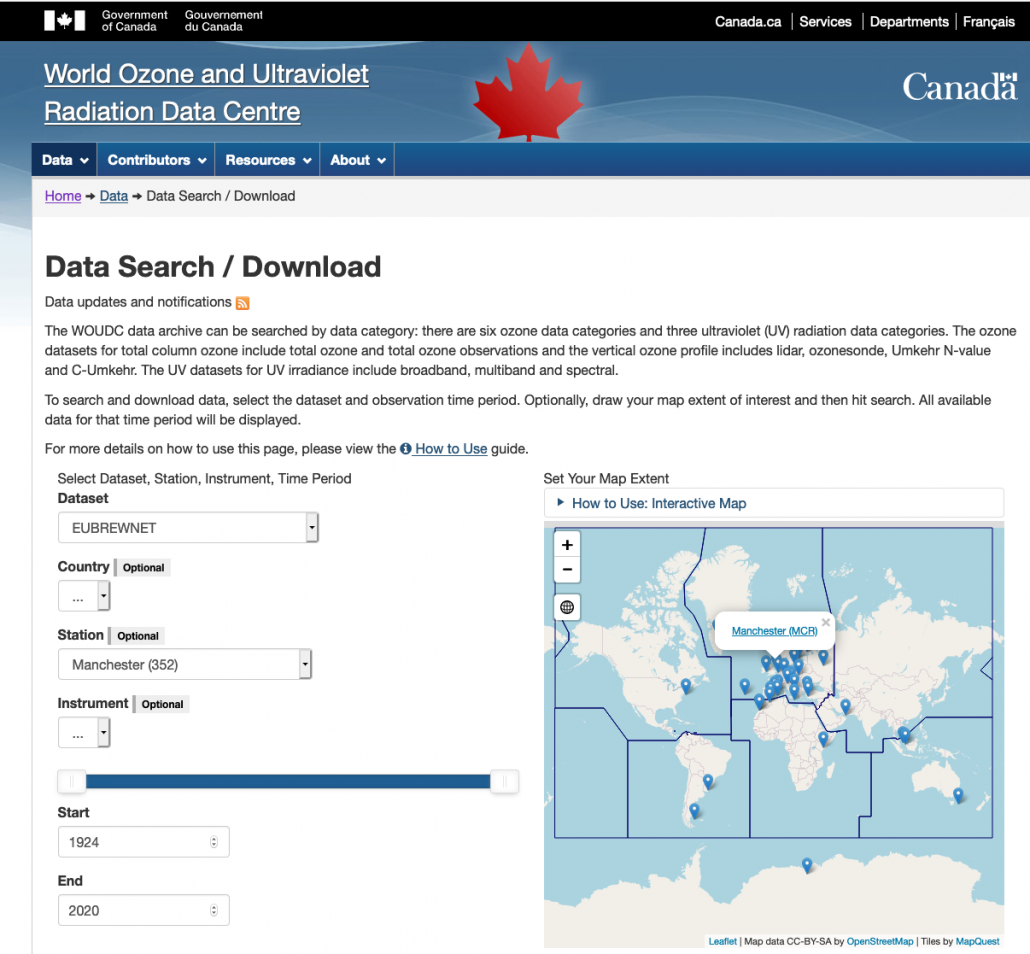
EuBrewNet-NDACC cooperative Agreement
During the last NDACC meeting a cooperative agreement between two networks was presented, this agreement mutually recognized both networks reinforcing the cooperation between two networks and maintained his own data policy.The stations/PI that participate on both networks with the same measurements continue to submit the observation to both networks. The agreement now in discussion for both networks can be read here.

The Izaña (Spain) and Uccle (Belgium) stations which take part in both networks are developing the real time submission of the Brewer V2 total ozone to the NDACC using EuBrewNet.
ET-ACQM – A new Expert Team on Atmospheric Composition Measurement Quality
Within the reorganization of the WMO a new structure was created by so called Expert Teams. The Expert Teams within GAW are now responsible for the advances in the research infrastructure in collaboration with SAG and the Infrastructure commision. This ET-ACQM will deal with the QA/QC of GAW measurements, and in the case of the Total Ozone the new group will combine activities that were part of the O3-SAG and SC-MINT (Standing Committee on Measurement, Instrumentation and Traceability) the former CIMO.

One of the objectives of these ET is to guarantee the quality of every GAW stored measurement:
- The measurement value is obtained following the SOP.
- Overall Uncertainty is reported and the traceability uncertainty chain documented
- Flag Code providing the state of processing /validation, reliability and representativeness.
- Metadata sufficient for data reprocessing from raw data.
Is clear that the Brewer total ozone observations has a lot of work to do starting with an unfinished SOP’s, the lack of uncertainty budget, traceability documentation, and in the case of WOUDC the impossibility to reprocess Brewer data starting from raw observations through a lack of metadata.
Associated to this Expert Team, a Total Column Ozone (including Umkehr) Task Force has been created with two co-chairs: Irina Petropavlovsky (Dobson) and Alberto Redondas with the following key topics to address:
- Introduction of the new cross-section and the temperature dependence.
- Uncertainty chain, traceability and metadata
- New instrumentation
- The Brewer gaps as mentioned afore.
EuBrewNet activities that were coordinated at O3-SAG are now under the umbrella of the ET-ACQM, the Ozone task force will bridge the NDACC and EuBrewNet total ozone activities.
Brewer Total Ozone Error Budget in EuBrewNet
Funded by ESA under the umbrella of the MPC TROPOMI project, the total ozone error budget of the Brewer ozone spectrophotometer developed during the ATMOZ project (final report link) will be implemented in EuBrewNet.
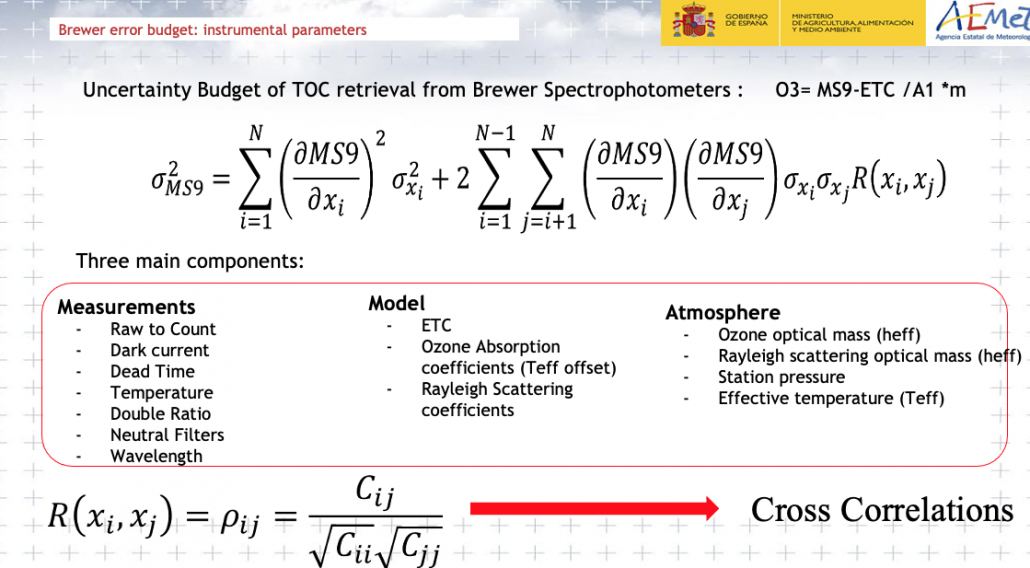
The model includes the effects of the three main components: measurements, atmosphere and model and takes into account the cross-correlations between the different parameters.
The measurement factors and calibration transfer errors were studied during the first phase of the project using the ATMOZ 2016 campaign for testing. The first results indicated that the major factor of the uncertainty is the Ozone Absorption Coefficient related parameters, followed by solar zenith angle, the calibration transfer and finally the measurement errors.

The 2σ uncertainties obtained for the ATMOZ 2016 campaign data at noon, using the standard algorithm are 2.5% for the reference instrument and 2.8% for the network instrument
Other important result of this first stage of the project is that some of the required uncertainties required for the error budget calculation are not available on the calibration reports, this includes the errors of the temperature coefficients and filter attenuation and the uncertainty of the measurement (MS9) due wavelength that can be extracted from the sun-scan measurements.
A python library that deals with the error budget calculation is under development for the implementation in EuBrewNet.
V2 updated Brewer Algorithm
During the last months, a preliminary version 2 of the ozone processing has been implemented in EuBrewNet. This processing, based on previous work from the Brewer community, has been proposed as one of the goals of the network since its inception. The updates included in the new ozone processing are:
- new ozone cross-sections (Bremen).
- ozone layer effective height and effective temperature for air mass calculation and ozone cross-sections correction.
- Rayleigh coefficients from Nicolet.
The preliminary version 2 of the EuBrewNet ozone processing can be accessed from the Process function: http://rbcce.aemet.es/eubrewnet/data/process/O3L1_5_V2?brewerid=185&date=2019-08-25&configid=1597&format=text
The parameters needed to process the data can be included in the Brewer configuration using the user interface at: https://rbcce.aemet.es/eubrewnet/configuration/list/OZONE
This V2 algorithm is now tested with the collaboration of the EuBrewNet stations of : Davos, El Arenosillo, Izaña, Madrid, Sodankylä, Tamanrasset, Thessaloniki and Uccle.

New AOD product
A new Aerosol Optical Depth product is now available in EuBrewNet. At this time, the AOD is determined from the DS ozone measurements following the method described in J. López-Solano et al., ACP, 18(6), 3885–3902, doi:10.5194/acp-18-3885-2018, 2018.
We have implemented in EuBrewNet’s data server the core functionality of the L1.5 ozone product with regard to automatic and manual processing, and database insertion and retrieval. For more information, see EuBrewNet’s wiki entries on the
- AOD configuration: http://rbcce.aemet.es/dokuwiki/doku.php?id=devel:eubrewnetconfiguration#brewer_aod_configuration
- AODL1_5 get function: http://rbcce.aemet.es/dokuwiki/doku.php?id=codes:dbaccess#get_aodl1_5
AODL1_5 process function: http://rbcce.aemet.es/dokuwiki/doku.php?id=codes:dbaccess#process_aodl1_5
Furthermore, we have also uploaded to EuBrewNet the AOD configurations for the El Arenosillo 2015 campaign (the same ones featured in the aforementioned paper), so for example you can use
to get the data for the last three days of the campaign for B#172 — see the next figure for the AOD at 320 nm for all the instruments at the campaign. It’s expected that calibrations for the more recent campaigns will be provided soon.
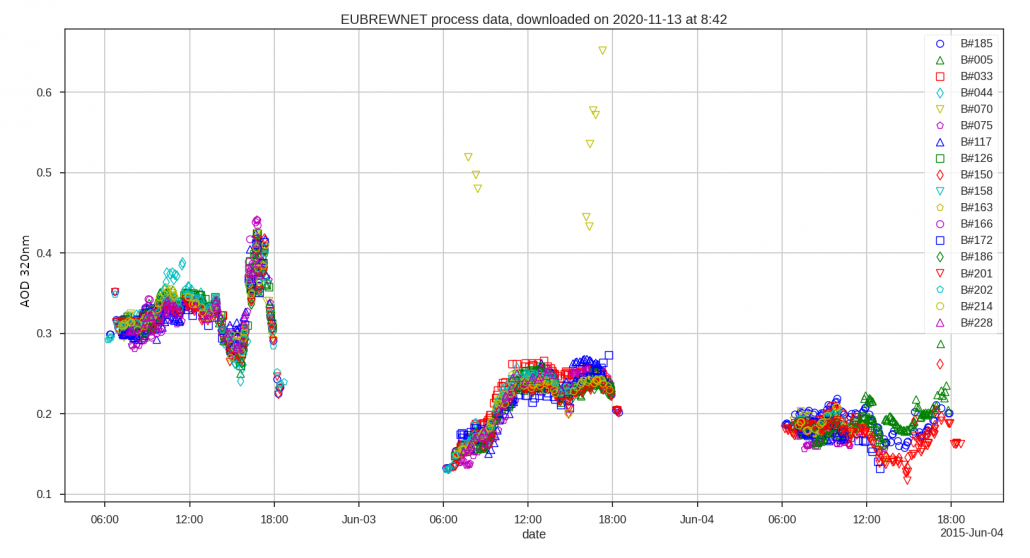
New users and Brewers
Twelve new users from all around the world (Netherlands, Finland, China, Ecuador, Mongolia, …) have joined our community this year, for a grand total of 137 registered users in EuBrewNet’s data server.
Also, three new Brewers, operating in Argentina and Chile, have joined EuBrewNet, raising the total number of instruments in our database to 107.
You can check the operative Brewers during the last week using this query:
http://rbcce.aemet.es/eubrewnet/stats/operative_brewers
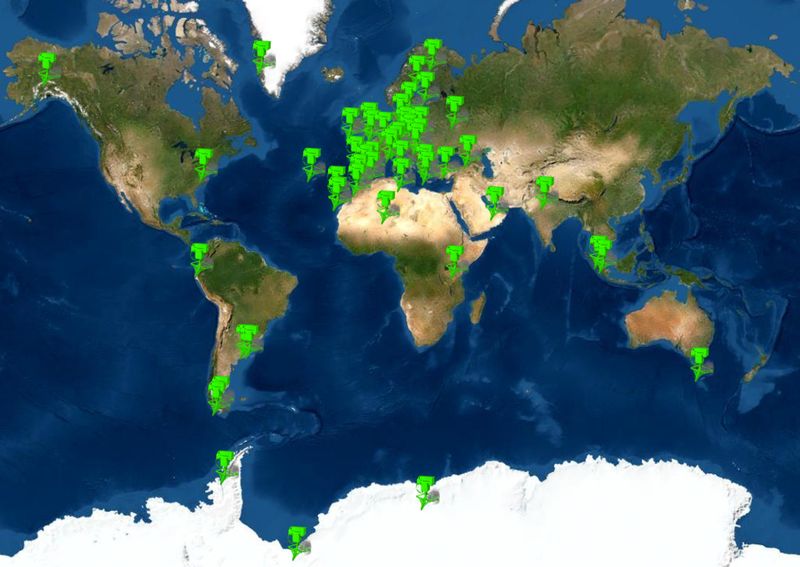
New version of EuBrewNet’s data submission client
We have updated the refresh client, fixing a couple of bugs and adding a much requested feature: a log file will now be written every time the client is run (the log file will be overwritten every time, so it won’t grow in size).
The log’s filename will be “refresh_log.BID”, where “BID” is the Brewer ID, and it will be placed in the same folder as the refresh client.
You can download the new version of the client from the usual links:
- http://rbcce.aemet.es/eubrewnet/static/files/client_exe.zip for the windows exe
- http://rbcce.aemet.es/eubrewnet/static/files/client_python.zip for the python code
New functionality in EuBrewNet
Exporting data
Data stored in EuBrewNet can now be exported in the WOUDC extCSV, GEOMS HDF, and NASA AMES file formats, see http://rbcce.aemet.es/dokuwiki/doku.php?id=codes:ozoneproduct for full details.
Thinking about future additions to EuBrewNet, we’re also looking at improving the structure of the GEOMS HDF files generated in our server. We would really appreciate it if you could take a look at
https://docs.google.com/document/d/1NQ2e1FCFH-vLZI26_ZUAF0fAjP5FR_kfcflBEdmC7E4/edit
and give us your feedback — thanks in advance!
Mean ozone and AOD values
The O3L1, O3L1_5, and AODL1_5 access functions can now return mean values over a requested time period appending “&mean=xt” to the URL. For example, to calculate the hourly means, you could use
and to get the daily means (see the next figure), the URL would be
See http://rbcce.aemet.es/dokuwiki/doku.php?id=codes:dbaccess#means for full details.
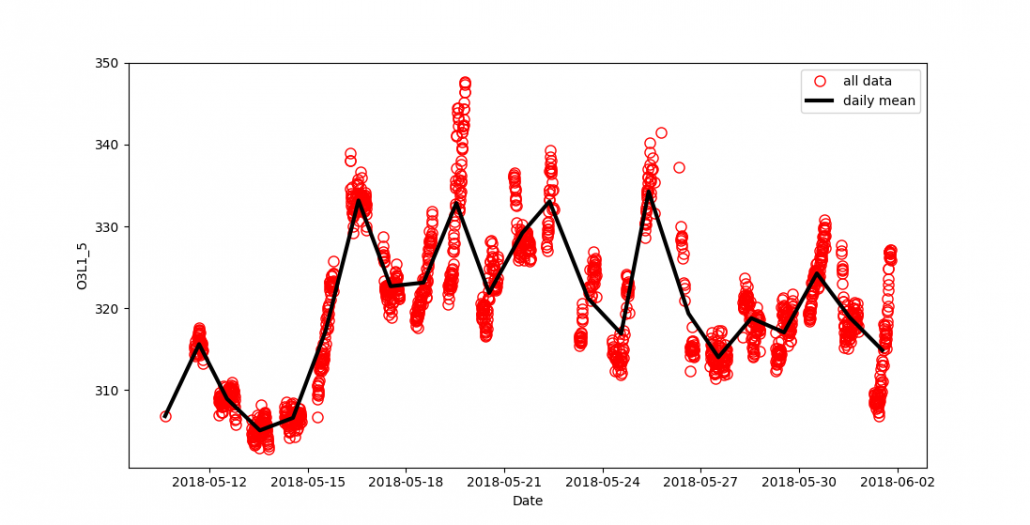
Bypassing data filters
You can now completely bypass any of the data filters applied to the output of O3L1_5 and AODL1_5 functions appending “&allowfilter=x” to the URL. For example, in the next figure we have plotted the results of
https://eubrewnet.aemet.es/eubrewnet/data/process/O3L1_5?brewerid=185&date=2018-11-01&format=text
and
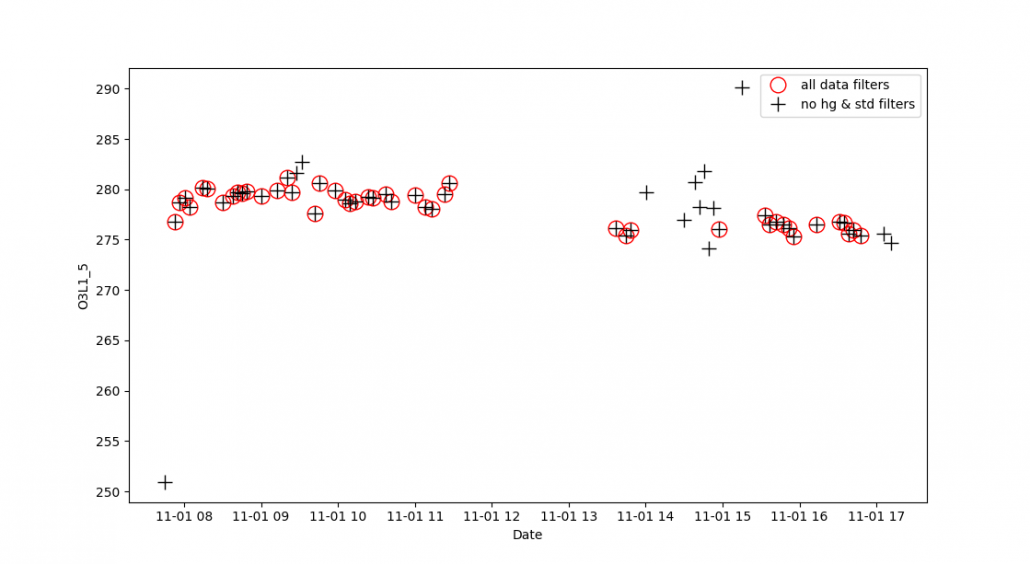
Note the extra data points when the data filters for the ozone standard deviation and Hg lamp tests are disabled (dataset marked with black crosses)
For more details, including a table with the names of the filters, see http://rbcce.aemet.es/dokuwiki/doku.php?id=codes:dbaccess&#bypassing_data_filters
Bypassing the exclusion list
If you just want to bypass some line of the exclusion list, you can append “&allowtag=xxx” to the URL of your process function, where “xxx” is part of a comment in the exclusion list.
For example, B#185’s data from the El Arenosillo 2019 campaign has been added to the exclusion list using the line
“2019-06-12 00:00:00, 2019-07-01 00:00:00, campaign are2019”
so you could use
to get the data of the campaign.
For more details, see http://rbcce.aemet.es/dokuwiki/doku.php?id=devel:eubrewnetconfiguration#getting_the_data_omitted_by_the_exclusion_list
Happy new Year!
